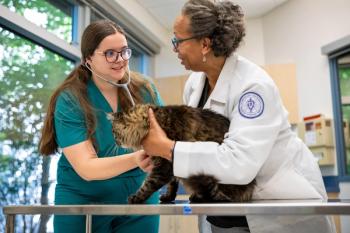
- dvm360 February 2020
- Volume 51
- Issue 2
Commentary: Time for action on student debt
There are many changes we could make to lower veterinary student debt. Its past time to start on one or two: raise more money and cut preveterinary requirements.
'Can we gather a sufficient sense of urgency to start now? Failure is not a viable option. We can do better.' (Cherries / stock.adobe.com)
The veterinary profession is operating in a rapidly evolving socioeconomic environment. This offers exciting new opportunities, including
As a college administrator, I attended a variety of conferences and consulted numerous books and papers about leading change. I was inspired by Harvard business professor John Kotter.1 He states that many organizations fail to complete needed changes because of their success. This seems contradictory, but Kotter explains that a major cause of institutional inertia is complacency-comfortable feelings of self-satisfaction induced by prior accomplishments. I am convinced that a hidden barrier to change in the veterinary profession is its success!
There have been many forward-thinking analyses of veterinary medicine, where the need for change was clearly identified.2 Some of the needs were debated repeatedly, yet the change efforts largely failed.3 Following extensive research with diverse organizations, Kotter concludes that “the single biggest error people make when trying to change [is] they do not create a high enough sense of urgency among enough people to set the stage for the challenging leap into some new direction.”1
The feeling of being overwhelmed prevents action instead of encouraging it, and attempting to address the many components of a complex problem all at the same time becomes part of the problem. A more rational strategy would be to choose just one or two potentially productive ideas that are relatively easily implemented and start them immediately.
Kotter also describes false urgency: unfocused, anxiety-filled, unproductive, busy work (task forces, etc.) without clear goals and timelines.1 Agonizing about the student debt crisis is false urgency. The challenge seems overwhelming: The median veterinary student debt is $174,000 and growing.4 If tuition continues on its current path, this figure will exceed $200,000 by 2025. We know we're in trouble; the economic drag on veterinary graduates is undeniable. The feeling of being overwhelmed prevents action instead of encouraging it, and attempting to address the many components of a complex problem all at the same time becomes part of the problem. A more rational strategy would be to choose just one or two potentially productive ideas that are relatively easily implemented and start them immediately.
Begin by vigorously expanding college fundraising efforts to create more and bigger scholarships and grants. At the same time, reduce the time for completing preveterinary course requirements to two years.5,6 Students will save tuition and living expenses and enter the veterinary workforce two years sooner. The AVMA Council on Education has accredited several international five- and six-year veterinary degrees, and some U.S. veterinary colleges have been accepting students after two years of undergraduate education for decades. There is no valid reason why this could not become the norm.6
When enhanced fundraising and two-year preveterinary education are underway, a college could then explore more difficult and contentious budgetary actions such as program reductions, administrative downsizing, DVM curriculum restructuring, etc. The specifics will vary from college to college.
How and when the student debt crisis will be fully resolved cannot be predicted. However, the decision to take action is within our purview. Can we gather a sufficient sense of urgency to start now? Failure is not a viable option. We can do better.
References
1. Kotter JP. A Sense of Urgency. Boston: Harvard University Press, 2008.
2. Dicks MR. A short history of veterinary workforce analyses. J Am Vet Med Assoc 2013;242:1051-1060.
3. Harris DL, Rosenthal K, Hines A. Thinking like a futurist could help the veterinary profession. J Am Vet Med Assoc 2019;255:523-524.
4. Mattson K. The veterinary student population by the numbers. J Am Vet Med Assoc 2019;254:1128.
5. Larkin M. Veterinary colleges look within for debt-reduction strategies. J Am Vet Med Assoc 2016;248:1320-1321.
6. Eyre P. The problem of student debt. J Am Vet Med Assoc (letter, in press).
Dr. Peter Eyre is a professor and dean emeritus at Virginia-Maryland College of Veterinary Medicine in Blacksburg, Virginia.
Articles in this issue
almost 6 years ago
Pet spending continues to break recordsalmost 6 years ago
Reading ECGs in veterinary patients: an introductionalmost 6 years ago
Fleas: How to conquer these blood-feeding, egg-laying machinesalmost 6 years ago
VMX 2020—Conquering canine anxiety during veterinary visitsalmost 6 years ago
Veterinary students attend VMX for freealmost 6 years ago
AVMA releases new pet euthanasia guidelinesalmost 6 years ago
Court rules against TV veterinarian Dr. Polalmost 6 years ago
AAFP releases updated feline retrovirus guidelinesalmost 6 years ago
New Year’s resolutionNewsletter
From exam room tips to practice management insights, get trusted veterinary news delivered straight to your inbox—subscribe to dvm360.




